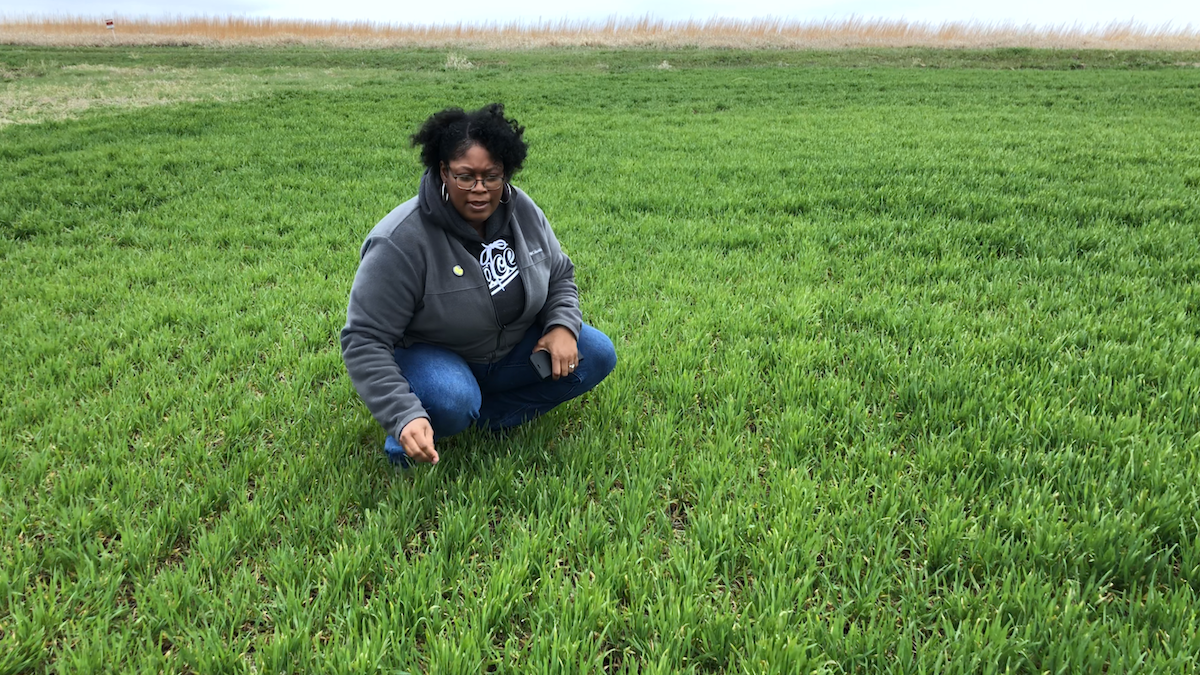After noticing the bread she was eating had more preservatives than flavor, she decided to give baking a chance. Her company, Doughp Creations, is equal parts hip hop, freshness and love. She said that she doesn't really have a bread journey or founder's story. "This found me. I did the best with what I had here. And I was interested in using local food, I was interested in family and I was interested in small business."
You start out right, you end up right, as Huggins says frequently and of course, good bread starts with good grain. Luke Peterson runs A-Frame Farm, a certified organic farm in Madison. Wanting to address climate change and also keep wealth in local communities, Peterson started reaching out to local grain buyers about five, six years ago. Huggins is a regular customer and Peterson thinks that her business model is what everybody wished the world would be like.
"I think it was like that at one time, I think we can get back to it and I think we have to get back to it. If you look at the way we buy and sell things right now, it doesn't necessarily consist of the buyer and the seller looking at each other in the eye and making a deal, which brings us back to the transparency part where we both know what we're getting when we work with each other," Peterson said. "Of the grain that I sell to Michele, like I keep saying it's fresh but I feel like that's really important considering the different techniques that are used for storing grain, ... how far has it traveled and how long has it been since it's been harvested.
Peterson said that Huggins is one of the most unique customers he has because of how conscious she is about from where she sources her grain. "She will come right to the farm and pick up a bag of our wheat berries," he said.
When it comes to baking her sourdough, Huggins mills her own flour. She used a hard red winter wheat from A-Frame Farm, called Redeemer. The off-white flour has a reddish tint to it. "It sounds a little different with the different grains that you grind. ... It's like the machine's working a little bit harder to mill it. I also have a soft white wheat and it goes through a little more smoothly in the mill, so I feel like that's kind of interesting and adds to the sound of making your bread."
Next, she makes her Doughp dough. Huggins prefers to start with her starter to avoid waste, which she mixes in lukewarm water. She feeds her starter a few hours before making her dough and uses a rubber band on the jar so she can see how much it's risen. "This starter has been going for years from when I first started it. You just keep feeding it and it grows. That sounds kind of gross for food, but that's what it is," Huggins laughed.
She mixes her milled grain and some white bread flour with the starter mixture, so she can demonstrate the slap and fold process.
She uses a special dough whisk to mix everything together. She says that the strategy at this point is to simply incorporate the wet and dry ingredients. "I feel like if I came in here with my hand it would like smush things and you don't want to start building gluten strands now. This is just to incorporate everything while it's on what's called auto lease." She said that after each stage of dough manipulation, the dough should rest so it can adjust to the changes that have been made. "It's kind of like, 'Simon says do this, Simon says do that,' and then you kind of get discombobulated. That's how you lose the game. But if you're able to rest, it's easier to follow directions," she said.
The dough then sits inside of her proofer for 30 minutes. Huggins describes a proofer as a heat box. She uses a proofer because she says that dough thrives in a warm environment. Then she adds salt, more water, and back to the proofer.
Next, it's the most action packed part of breadmaking — aside from the actual eating of the bread — the slap-and-fold process. Huggins' method is to turn on some hip hop, remove any and all jewelry, get into the slap-and-fold position: wide stance, elbows out, and work the dough. She uses the dough's weight to help it knead itself. This process works out some of the stickiness, develops gluten strands and incorporates air.
"I think this is fun. Sometimes I do it harder, if I'm mad."
After the initial slapping, she'll let it sit, let it rest. Then two more rounds of a slightly gentler stretching and folding and it'll sit in the proofer for several hours to rise.
The baking stage has two rounds. The first is 45 to 60 minutes of covered baking and when the bread is done, it has a beautiful golden brown crust. "So you see it's got some oven spring, but it doesn't have a lot of color yet, so you take the lid off and let it brown a little bit more." This is the stage where you can also see her trademark scoring mark, which looks like a cactus. Huggins pushes the bread back into the over and after another 45 to 60 minutes, the bread is done.
Once a week, Huggins stops by the Neighbors United Resource Center Food Shelf to drop off her Neighbor Loaves. "I'm part of the AGC, which is the Artisan Grain Collaborative, and they provide a program called Neighbor Loaves, in which artists and bread makers, whether they're cottage bread makers like myself who bake from home or larger bakeries, donate to their local food shelf or place in need in their community," Huggins explained.
People can sponsor these bakes; pay bakers to bake bread that they donate. Huggins says that she feels she can provide at least a dozen loaves, whether she's sponsored or not. "I feel like this grain is important enough that people need to know," Huggins said. "It's healthier than some of the other products that we have on the shelf, but it makes me feel good and I know that it's needed."
The Granite Falls Food Shelf is open from 9 a.m. to 3 p.m. on Wednesdays and serves Yellow Medicine and Chippewa counties. Huggins is also part of Bakers Against Racism. She said that over the past year, especially with the heightened awareness around police brutality towards people of color, she's felt the need to bake for a bigger cause. "I was holding a lot of negativity and negative energy and just like what can I do and what can I do from here? So I just started finding fulfillment in my heart by giving back to my community, knowing my neighbor," she said."
She said, in many ways she identifies with dough. "It's like me, it takes time. It's temperamental and it's misunderstood. But once you digest it, you realize the awesome benefits that it has to offer. I think that that's me here and as people get to know me, I think I'm cool. Hang out with me."
Huggins is based in Granite Falls, but anyone can order her homemade sourdough on her Etsy page. Just search for Doughp Creations.




